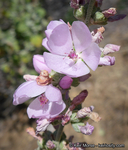Taxon Report
Malacothamnus hallii (Eastw.) KearneyHall's bushmallow |
 © 2017 Keir Morse |
Taxon Summary
Malacothamnus hallii, commonly known as Hall's bushmallow, is a perennial deciduous shrub in the Malvaceae that is found only in California. It occurs within Chaparral, and Coastal scrub, growing at elevations from 10 to 760 meters. Malacothamnus hallii is ranked 1B.2, Plants Rare, Threatened or Endangered in California and Elsewhere; Moderately threatened in California.Classification
|
Scientific Name: |
Malacothamnus hallii (Eastw.) Kearney |
|
Common Name: |
Hall's bushmallow |
| Family: | Malvaceae |
| Element Code: | PDMAL0Q0F0 |
| USDA Plants Symbol: | |
|
Synonyms/Other Names: |
|
Ecology and Life History
| Lifeform: | perennial deciduous shrub |
| Blooming Period: (Apr)May-Sep(Oct) | (Apr)May-Sep(Oct) |
| Elevation: | 10-760 (35-2495) |
| General Habitats: | Chaparral, Coastal scrub |
| Microhabitat: | |
| Microhabitat Details: |
Conservation Status
| CA Rare Plant Rank: | 1B.2 |
| Global Rank: | G2 |
|
State Rank: |
S2 |
| State List: | None |
| Fed List: | None |
| Other Status: | BLM_S; SB_CalBG/RSABG |
|
CRPR Changes: |
|
Occurrence Data from the CNDDB
| Total Occurrences: | 71 |
| Element Occurrence Ranks: | |
| Excellent (A) | 3 |
| Good (B) | 9 |
| Fair (C) | 8 |
| Poor (D) | 2 |
| None (X) | 1 |
| Unknown (U) | 48 |
| California Endemic: True | |
| California Counties and Islands: Name (Code) | |
| Contra Costa (CCA), Merced (MER), Santa Clara (SCL), Stanislaus (STA) | |
| Quads: Name (Quad Code) | |
| Antioch South (3712187), Calaveras Reservoir (3712147), Clayton (3712188), Diablo (3712178), Loma Prieta (3712117), Lone Tree Creek (3712154), Los Banos Valley (3612181), Milpitas (3712148), Mississippi Creek (3712124), Morgan Hill (3712126), Mustang Peak (3712123), Pacheco Pass (3712112), Pacheco Peak (3712113), San Jose East (3712137), San Jose West (3712138), Santa Teresa Hills (3712127), Solyo (3712153), Three Sisters (3612183), Walnut Creek (3712281) | |
Threat List Data from the CNDDB
| Threat List Total: | 12 | |
| EOs with Threat Listed: | Total EOs | % of EOs |
| 24 | 34 % | |
| Grazing | 8 | 11% |
| Other | 6 | 8% |
| Road/trail construction/maint. | 6 | 8% |
| Non-native plant impacts | 4 | 5% |
| Development | 3 | 4% |
| Erosion/runoff | 2 | 2% |
| Feral pigs | 2 | 2% |
| ORV activity | 2 | 2% |
| Improper burning regime | 2 | 2% |
| Foot traffic/trampling | 1 | 1% |
| Dam/Inundation | 1 | 1% |
| Recreational use (non-ORV) | 1 | 1% |
Citation
California Native Plant Society, Rare Plant Program. 2025. Rare Plant Inventory (online edition, v9.5.1). Website https://www.rareplants.cnps.org [accessed 15 December 2025].